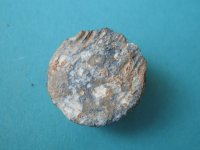Emike's guess is correct, Shack. This item is definitely the sideplug from an exploded Sideloader CS Case-Shot.
Sideloader-plugs were always threaded into the shellwall, and they are normally found with their threads "mostly" intact. Though most of your lead plug's threads are not visible, a few show in your 4.jpg photo.
Here's why your sideloader-plug shows few threads ...and also, why yours has a concave underside.
Lead sideplugs were made by twist-forcing a long ROUND bar of soft lead into the shell's threaded iron sideloading-hole. The lead bar was then cut off flush with the shell's surface ...thus creating a lead sideplug ...and then any protrusion on the lead plug's external side was hammered flat. (This accounts for the evidence of hammering on your plug.)
Note that neither side of such plugs was concave when it was installed in the shell.
It appears that when the shell detonated, your sideplug was violently driven out of its threaded hole in the shellwall by a "direct hit" from one of the iron case-shot balls inside the shell. That case-shot ball left its spherical impression deep in the plug's "internal" side.
Your lead plug's threads were mostly smeared away when it was forced out of its threaded hole by the iron case-shot ball.
The presence of this lead sideloader-plug at the dig-site means fighting occurred there during or after Spring 1863. That's when Sideloader Case-Shot makes its first appearance in the war.
Also... the presence of this lead sideloader-plug indicates the small (approximately .5 to .7-inch diameter) iron balls you found at the construction site are Confederate sideloader case-shot balls ...not "grape shot."

Regards,
Pete [PCGeorge]




